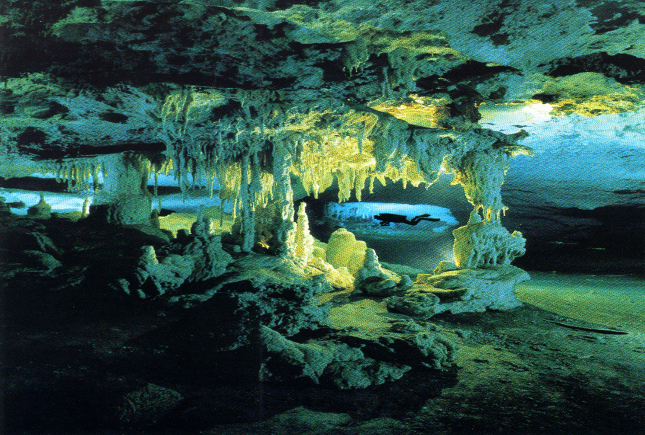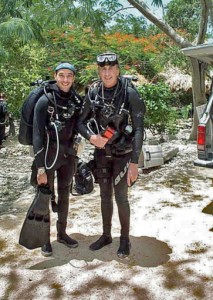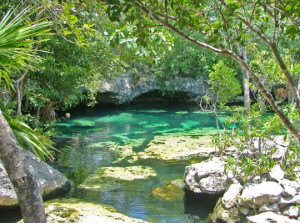Marine Life & Conservation
The Yucatan Cenotes – A paradise under threat from tourism

An interview with Sam Meacham by Jeff Goodman
A few years ago I made a film for the BBC called ‘Secrets of the Maya Underworld’ and was about the Cenotes and forests of the Yucatan Peninsula, Mexico. Previously I had always promised myself not to ever cave dive as I had a fear of being lost or trapped far underground with no escape route. Then a few very good friends told me of the Cenotes and the incredible wildlife that was associated with them. I had to see for myself.
 It was then I met Sam Meacham, an American living near Cancun. He had been exploring the caves and passageways of the Yucatan Peninsula for the previous 18 years and now to date has discovered with other divers 252 known caves and cave systems in that region with a total of 1,103.3 km or 685.5 miles of surveyed passageway between them. Two of the five longest caves on the planet Sistema Sac Actun and Sistema Ox Bel Ha are found close to the town of Tulum.
It was then I met Sam Meacham, an American living near Cancun. He had been exploring the caves and passageways of the Yucatan Peninsula for the previous 18 years and now to date has discovered with other divers 252 known caves and cave systems in that region with a total of 1,103.3 km or 685.5 miles of surveyed passageway between them. Two of the five longest caves on the planet Sistema Sac Actun and Sistema Ox Bel Ha are found close to the town of Tulum.
The Yucatán Peninsula was once a shallow coral reef and now over a few million years has become a porous limestone shelf covered with forest and wildlife. There are no visible rivers; all the fresh water rivers are underground. Being porous, caverns and caves formed where the fresh water collects – hence the Cenotes or water sinkholes.
Recently, the Cenotes have become a great dive destination and the eastern Yucatan coastline an ever developing tourist area for sun worshipers and beach goers. The seemingly uncontrolled developments are taking their toll on this unique ecosystem.
I recently got back in touch with Sam to see if things were improving.
Jeff: Can you just tell us exactly what the Cenotes are and what is so special about them?
Sam: Cenotes are karst sinkholes that occur in Mexico’s Yucatan Peninsula. The Cenotes are windows into the freshwater aquifer of the region and the entrances to the very complex flooded solution cave systems along the Caribbean coastline.
 Jeff: The underground water systems give life to the forests above where wildlife is obvious to find, but is there life in the caves as well?
Jeff: The underground water systems give life to the forests above where wildlife is obvious to find, but is there life in the caves as well?
Sam: Most people think of the cave environment as a very sterile place. In fact, there are over 40 life forms so far identified that live in the dark recesses of these caves. The majority are crustaceans and they are all considered extremeophiles because of the conditions they live in. The Cenotes themselves are also magnets for life; this includes a number of freshwater tropical fish species, crocodiles, turtles in the water and birds and mammals (including jaguars) at the surface.
Jeff: How long has man know about the Cenotes?
Sam: There is growing evidence that the caves and Cenotes were accessed by humans during the last ice age, which was 8000-10000 years ago.
Jeff: Did the Maya have any idea about the complexity of the underground waterways?
Sam: It is hard to say if the Maya realized that some of the Cenotes were connected by the intricate and complex cave systems. Many of the underground rivers flow out to the sea in very impressive upwellings; perhaps they put two and two together when they observed this. It was not until the 1980’s that cave divers really began to probe the depths of the Cenotes and really revealed just how complex and extensive they were.
Jeff: Are the Cenotes and reliant ecosystems in any threat now due to the commercial tourist developments?
Sam: There is a very real and continuing threat from the development of the tourism industry along the coastline. Karst landscapes like the Yucatan are very susceptible to contaminants that leach through the porous limestone and into the aquifer.
Jeff: What are the main issues?
Sam: The main issues we face are contamination from solid waste (garbage) and sewage. Once contaminants hit the aquifer there is the high potential for them to be transported through cave conduits and out to the Caribbean Sea. High concentrations of contaminants cause algal blooms that cover the Mesoamerican Reef and kills the corals. If we lose the reef, we lose the protection to the beaches. If the beaches erode, where will the tourists go? Effectively, we risk killing the goose that lays the golden egg.
Jeff: Is anyone listening to the conservation needs of the area or is commercialism taking its full toll?
Sam: Well, I think worldwide conservation efforts are always facing an uphill battle and this area is no exception. But I do think there is a great deal more awareness about the existence and importance of the flooded caves. My personal belief is that the outreach and education about the caves is the only way we can engage the public and effect change.
Jeff: As Divers, how can we help preserve this unique ecosystem?
Sam: If you dive in the Cenotes, it is a great opportunity to perfect your skills particularly your buoyancy and trim. Really, any time you go diving you should be perfecting your skills. We, as divers, are privileged visitors to the underwater environment and must make every effort to protect it.
Jeff: If readers want to learn more where can they get further information?
Sam: Here are a few websites:
Marine Life & Conservation
Paul Watson Released as Denmark Blocks Japan’s Extradition Bid

Renowned anti-whaling activist Paul Watson has been released from custody in Greenland after spending five months in detention. Denmark’s Justice Ministry rejected Japan’s request for his extradition, citing insufficient guarantees that his time already served in custody would be credited against any potential sentence.
The 74-year-old Canadian-American was arrested on July 21 in Nuuk, Greenland’s capital, when his ship docked to refuel. His arrest was based on a 2012 Japanese warrant related to a 2010 encounter in Antarctic waters. Japan alleged Watson obstructed operations and caused damage to a whaling research ship during efforts to disrupt illegal whaling. Watson has consistently denied these claims, maintaining his commitment to marine conservation.
Denmark, which oversees extradition matters for Greenland, concluded that while the legal conditions for extradition were met, the lack of assurances from Japan regarding time-served credit made extradition untenable.
In a video shared by his foundation, Watson expressed gratitude and relief, saying, “After five months, it’s good to be out… and good to know they’re not sending me to Japan.” He added that the most difficult part of his time in custody was being separated from his two young sons.
Watson is a pioneering figure in marine conservation, known for founding the Captain Paul Watson Foundation in 2022 after decades of activism with the Sea Shepherd Conservation Society. His bold efforts to defend marine life have earned him widespread support, including from celebrities and conservationists. His work has also been featured in the acclaimed reality TV series Whale Wars.
Watson’s lawyer, Jonas Christoffersen, praised the decision, stating, “We are happy and relieved that Paul Watson is now free.” He added that Watson is eager to reunite with his family and continue his vital work.
The arrest occurred while Watson’s vessel, the M/Y John Paul DeJoria, was en route to the North Pacific with a team of 26 volunteers to intercept a Japanese whaling ship. His foundation described the arrest as politically motivated and emphasized that Watson’s actions were focused on ending illegal whaling practices.
Japan resumed commercial whaling in 2019 after leaving the International Whaling Commission, asserting that whale meat is a cultural tradition. Conservationists, however, continue to challenge these practices, highlighting their impact on marine ecosystems.
Despite the challenges, Watson remains steadfast in his mission to protect marine life and bring attention to whaling practices. His dedication to ocean conservation has made him a globally respected advocate for the environment.
Marine Life & Conservation
12 Days of Zero-Waste Fish-mas

This holiday period, the Marine Conservation Society, the UK’s leading ocean membership charity, invites you to make some simple changes to eating fish this Christmas to help our seas.
Dr Kenneth Bodles, Head of Fisheries and Aquaculture at the Marine Conservation Society, said, “During the festive season, our consumption increases, but so does waste. Sustainability isn’t just about where food comes from – it’s also about how you use it. By reducing waste and making the most out of your seafood, you’re not only taking steps to be more ocean-friendly, but can also help to cut costs during what is often one of the most expensive times of the year”.
The Marine Conservation Society has compiled twelve tips on how to consume seafood sustainably with zero-waste this Christmas:
Buy whole fish instead of fillets
Instead of fillets, consider buying whole fish such as salmon, hake, or lemon sole. By adopting a “nose to tail” approach with cooking, whole-baked fish not only feeds a crowd, but also helps to minimise waste and maximise sustainability by using up every part of the animal, including bones, skin, and fat.
Make fish stock
Leftover fish bones or shells can be put to good use by boiling them to make a nourishing fish stock or bisque. This can be frozen and preserved for later use and makes for a flavourful base in a soup.
Make your own fish pâté
Avoid waste by turning leftover fish, such as smoked mackerel or salmon, into a delicious pâté by blending with cream cheese and lemon. Perfect when paired with crackers.
The sustainability of salmon and mackerel varies depending on where and how it is caught or farmed. For more information on green-rated options, check the charity’s Good Fish Guide.
Buy frozen
By purchasing seafood that is frozen or vacuum-packed, this helps to reduce waste by extending the shelf life of your food.
Fish pie
If you’re wondering what to do with leftover cooked fish, why not opt for a classic fish pie with mashed potatoes, leeks, and a cheesy sauce? A sure crowd pleaser on Boxing Day.
Use the head
Don’t forget the fish head! The meat is incredibly tender and flavourful. The charity recommends a cod’s head curry or recreating Fallow’s renowned cod’s head in siracha butter.
By stretching your ingredients further, not only is this a more sustainable way to enjoy seafood, but also cost-effective by repurposing leftovers and cooking creatively.
Boxing Day brunch
Mix leftover kippers or smoked salmon with scrambled eggs for a tasty, zero-waste, Boxing Day brunch.
For best choice, make sure you buy kippers, or herring, from the North Sea and the North Irish Sea.
Zero-waste storage
A top tip from the Marine Conservation Society to avoid waste is freezing fish offcuts to save for future use.
Crisp up the skin
Even leftover fish skin can be turned into a quick savoury snack by crisping it up in an air fryer with a little olive oil and salt.
Anchovies two ways
Leftover anchovies can either be blended with butter to make a delicious anchovy butter or tossed into pasta for a hit of umami flavour.
The charity recommends opting for anchovies caught in the Bay of Biscay for best choice.
Fishcakes
For an easy, zero-waste meal, leftover seafood trimmings can be mixed with mash and fried in breadcrumbs to make fishcakes.
Pickled mussels
Try pickling mussels in 1:1 vinegar and water, with a dash of sugar for a sustainable, zero-waste snack that can be enjoyed well beyond the festive season.
Mussels farmed in the UK are a seafood superhero. Grown using low-impact methods and harvested by hand, they get all the food they need from the sea around them. This makes them one of the most sustainable, ocean-friendly, and cost-effective seafood options.
Players of People’s Postcode Lottery have raised £6.6M towards the Marine Conservation Society’s vital work in making seafood more sustainable.
Laura Chow, Head of Charities at People’s Postcode Lottery, said: “Fish is a festive favourite for many, but making sustainable choices when it comes to how we buy and eat seafood makes all the difference for our ocean. Support from players of People’s Postcode Lottery has helped the Marine Conservation Society further its sustainable seafood work, so that we can all enjoy healthier, better protected seas.”
The Marine Conservation Society encourages you to make sustainable seafood choices a year-round habit, not just for Christmas. To check how sustainable the seafood on your plate is, you can visit the charity’s Good Fish Guide. The Guide helps consumers and businesses identify the most sustainable seafood using a simple traffic light system, based on where and how species are caught or farmed. Green is the best choice, amber means improvements are needed, and red indicates fish to avoid buying.
Zero-waste gift idea
Why not embrace a zero-waste Christmas by gifting a membership to support marine conservation? It’s a meaningful, low-waste gift that helps protect our ocean for generations to come. Memberships start from as little as £5 a month – the price of a sandwich and drink from your local coffee shop.
Find the latest sustainable seafood advice for wild-caught and farmed seafood on the Good Fish Guide, downloadable to your phone from www.mcsuk.org/goodfishguide.
-

 News2 months ago
News2 months agoIconic SS United States to become the World’s Largest Artificial Reef
-

 News3 months ago
News3 months agoBook Review – 52 Assignments: Underwater Photography
-

 Gear News3 months ago
Gear News3 months agoDYNAMICNORD – New German diving brand enters the British market
-

 News3 months ago
News3 months agoExploring Cenote El Pit: A Diver’s Dream
-

 Gear News3 months ago
Gear News3 months agoTry BARE drysuits (and maybe even win one!) this Friday with Sea & Sea at North West Dive Fest
-

 Marine Life & Conservation3 months ago
Marine Life & Conservation3 months agoBook Review: Coral Triangle Cameos
-

 Blogs2 months ago
Blogs2 months agoDive the Egyptian Red Sea this Autumn with Regaldive
-

 News3 months ago
News3 months ago2024 Ocean Art Underwater Photo Competition Announced



